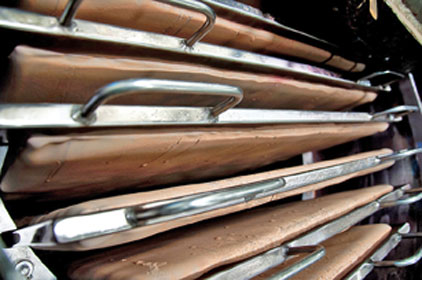“The company was growing, and our 15-year-old filtration system couldn’t keep up with our production requirements,” explains Eli Herzog, vice president in charge of production at Royal Wine Corporation. “No matter what we did or how hard we tried, it would not perform. We thought the only solution was to purchase a new filtration system, a major capital equipment expense. But when we contacted Newark Wire Cloth Company in our search, Marvin Greenstein, its director of engineering, offered an alternative: redesign the filter leaves.”
The filter consists of a vessel that houses internal filter surfaces including the filter leaf, which is a major factor in determining the efficiency of a filter. “We sent Mr. Greenstein a leaf to look at, and indeed, he said Newark Wire Cloth could improve upon it,” recalls Herzog. “So we gave them an order, they sent us a redesigned leaf—a totally different design—and I am happy to say it more than did the trick.
“We use nine filter leaves and filter all our incoming products from the tank trucks as they arrive,” continues Herzog. “It is extremely important that the initial quality be exceptional because this is our first line of defense, and we make all our different products from this filter. Newark Wire Cloth redesigned each of the nine leaves we use.”
But the vintner didn’t stop there. “We now add a body feed, which is the insertion of small amounts of filter aid to the influent during the filter cycle,” says Herzog. “This separates the contaminant particles and prevents them from conglomerating and sealing off the surface of the pre-coat layer which would prevent further flow. After the leaves are pre-coated, we put very small amounts of additional pre-coat [in a water base] into the product as it comes in from the tank truck; this increases the spacing between the contaminants so we can get even longer runs.”
Even so, the increase in production has been primarily due to the leaf design since the filter leaf deals with the day-to-day maintenance and product quality details. It quickly and ultimately determines the success of the process.
“We tripled our production,” says Herzog, “and we increased the total flow through our filter two and a half to three times more than it was before. For an expense equal to a third of what a new filter would have cost, our problem was solved. We have better production, and maintenance is a lot easier.”
Nothing builds up in the filter leaf because of its construction. “It is an all-welded, wire-mesh filter leaf, and the 5/16-in. thick drainage chamber is just that, a true drainage chamber that provides the proper lateral flow to the outlet,” adds Herzog. The leaves now pre-coat uniformly and filter efficiently, resulting in the increased filtration cycle and ease of cleaning, according to Herzog.
For more information:
E. Marvin Greenstein, 800-221-0392,
emgreenstein@newarkwire.com, www.newarkwire.com


